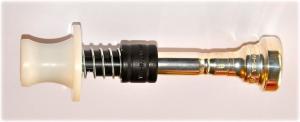I’ve had the chance over the last few weeks to play around with a variety of tools from Warburton USA, a manufacturer of cool brass instrument related gadgets and practice tools. This week I’m looking at the Anti-Pressure Exerciser (The A.P.E.) and how it can be used as a teaching tool or for general practice on the trumpet, French horn, or tenor trombone. What exactly is the A.P.E. and why should you consider getting one to use with your students? Read on to find out.
Brass musicians have one general reflex that crosses the boundaries between all of the instruments. As we try to play higher we naturally press our lips against the mouthpiece more firmly. If not properly guided by a responsible teacher, a trumpet player, hornist, or trombonist can develop bad habits that lead to using too much of this pressure on the higher notes, distorting the embouchure and causing problems both in terms of range and muscle development. The A.P.E. is intended to help the user realize these bad habits and help them retrain their playing style to press less. The benefits over time being increased endurance and a better quality buzz sound.
How Does The A.P.E. Fix Pressure Issues?
The A.P.E.’s sole purpose is to help you become aware of how much pressure you are using against the lips. You place your mouthpiece into the A.P.E. and buzz normally. As you increase the inward pressure from the mouthpiece a small spring compresses. When you push too hard, to the point of what could be considered dangerous to the embouchure, a valve on the A.P.E. closes, blocking the air from going through and giving you an instant wake up call that you need to change your technique. It also functions as a decent buzz extender similar to another Warburton product, the Buzzard.
I’ve used the A.P.E. with several students as they make their first journeys up to the notes above third space C on the trumpet and while none of them pushed so hard as to close off the valve it was interesting to watch them pay attention to just how much pressure they were using. It’s a great diagnostic tool as well as a functional practice device to help correct the problems if they are already apparent on a given player.
Is the A.P.E. Worth Investing In?
In general the A.P.E. is well worth the $50 investment to add one to any music teacher’s bag of tools. In my opinion it should be as ubiquitous in use as a mouthpiece visualizer often is, allowing us to notice problems before they appear and provide a solution to fix anything that is already going wrong with a student’s embouchure. Grab one and give it a try with your students and see for yourself.

